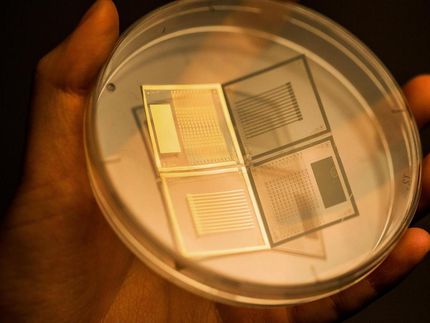Haute Couture from the Experimental Physics Lab
A team of Austrian physicists has recently developed ultra-thin pressure sensors that can also be processed into sensitive textiles. The breakthrough came with the arrival of technology for building up a sufficiently large electrical field in polymer foams. This enabled thin-film transistors to switch in reaction to pressure. Possible applications arising from this project funded by the Austrian Science Fund FWF include ultra-thin microphones, pressure sensors for replacement skin, and interactive clothing.
Pressure sensitive foils have also been around for some time. Known as ferroelectrets, these are electrically charged polymer foams that generate an electrical signal in reaction to pressure. It has not been possible in the past to use this signal to switch thin-film transistors. However, a joint Austrian and American team has recently achieved the development of ultra-thin, pressure-sensitive switches that have a range of potential applications as a result of their sensitivity and low production costs.
"The key factor is the correct coating of the components," explains project manager Prof. Siegfried Bauer from the Institute of Experimental Physics at the Johannes Kepler University in Linz. "We applied a propylene foam over a TFT on a polyimide base. These are the type of TFTs we know from flatscreens." The polymer propylene foam is the actual sensor. When pressed, the differently charged sides of the individual cavities in the foam converge and produce an electrical signal. Prof. Bauer explains: "The great thing about this combination is that the transistor switches only temporarily. If the pressure on the propylene layer decreases, the transistor reverts to its original state. Previously similar experiments only created permanent switching of the transistor. The transistor did not revert to its original state. That is naturally not ideal for a pressure sensor. It would still generate a signal even if the pressure were released."
The practical benefits of the work conducted by the team made up of Prof. Bauer and his colleagues at Princeton University in the U.S. stem from two facts. First the pressure sensitivity is high and exists at different pressure intensities, and second the materials used are cheap.
Prof. Bauer explains: "The pressure sensitivity of the sensor in our measurements ranged from just a few pascals to one megapascal. This is a difference of six orders of magnitude. A voltage of up to 100 V was measured, which is more than enough to switch the transistors. In fact, our calculations showed that the voltages could reach up to 340 V, but these could not be measured directly due to the capacities in the measuring apparatus."
Original publication: Graz et al.; "Flexible ferroelectret field-effect transistor for large-area sensor skins and microphones."; Applied Physics Letters 2006, 89.
Most read news
Organizations
Other news from the department science

Get the analytics and lab tech industry in your inbox
By submitting this form you agree that LUMITOS AG will send you the newsletter(s) selected above by email. Your data will not be passed on to third parties. Your data will be stored and processed in accordance with our data protection regulations. LUMITOS may contact you by email for the purpose of advertising or market and opinion surveys. You can revoke your consent at any time without giving reasons to LUMITOS AG, Ernst-Augustin-Str. 2, 12489 Berlin, Germany or by e-mail at revoke@lumitos.com with effect for the future. In addition, each email contains a link to unsubscribe from the corresponding newsletter.

























































